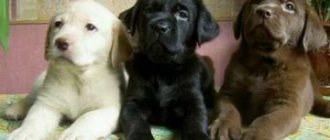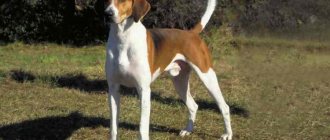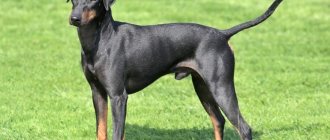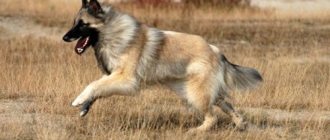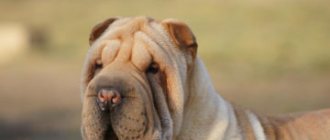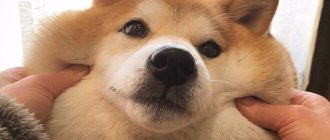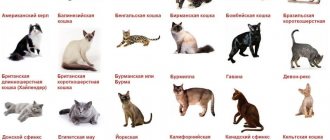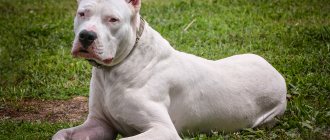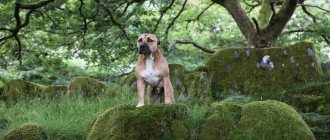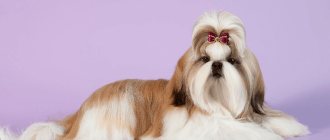Many dog experts are of the opinion that the Landseer is a type of Newfoundland. However, in the middle of the 17th century it was decided to introduce the breed into a separate standard. As is commonly believed, the Landseer breed was developed thanks to English noblemen who crossed the Newfoundland and the British dog, now considered extinct. The mixing of the two breeds was able to produce the so-called black and white variety of Newfoundland, accounting for 18% of the total population. This cute breed was named after an artist named Edwin Henry Landseer, who is famous for his paintings of these beautiful black and white Newfoundlands. Since that time, the breed has gained its popularity.
Description and standard of the Landseer breed
Height at withers: 67-80 cm Weight: 50-60 kg
Color: spotted. The base color is white, on which symmetrical spots of black are scattered. On the back there are spots in the shape of a cloak or saddle; the head can be completely black with a white blaze. Speckling is allowed on the paws, and frost on the face. If the Landseer has been in the sun for a long time, then a reddish-brown coating may appear on the black spots.
- The coat is thick, long, harsh to the touch, forms feathers and trousers on the paws, a mane on the neck, and no dewlap on the tail. On the back, a parting is sometimes formed along the spine. The undercoat is soft and thick, does not get wet in water.
- Sexual dimorphism is pronounced: males are larger than females and more courageous than females.
- The physique is muscular, with a stretched format, a straight back and a broad chest.
- The “bear” head is wide, rounded in the skull, with a short muzzle and developed cheekbones. The shape resembles a blunt wedge.
- The ears are drooping with rounded ends, set high and close to the cheeks.
- The eyes are small, oval, hazel or brown in color.
- The nose is wide and black.
- The tail is long, thick, the dog carries it like a sickle at the level of the back, and lowers it down when calm.
Purpose
Despite its gigantic size, the dog is not well suited for home guarding due to its kind nature and love for people. The Landseer will be an excellent companion dog for a family, a rescue dog in mountainous areas or near-water environments, as its thick fur will prevent it from freezing, and well-developed webbed feet make the Landseer an excellent swimmer.
History of the breed
The history of the breed began in Germany and Switzerland. Although there is a version that this breed originated on the island of Newfoundland. The ancestor is considered to be the pet of St. John, who knew how to swim and fish perfectly. Therefore, the Landseer loves water from birth and is ready to spend a lot of time in it.
In the 18th century, dogs of this breed came to England, where they were popular and mistakenly recognized as the English version of the Newfoundland.
The name of the breed is the surname of the artist Edwin Landseer, who depicted black and white dogs in his canvases. Therefore, for a long time Landseers were called “Landseer Newfoundlands”. Landseers were also mentioned in literature, Byron wrote about them.
"A Worthy Member of the Humane Society" by Edwin Landseer
"Saved" by Edwin Landseer
At the beginning of the twentieth century, Landseers almost disappeared - they were saved by German fans who crossed representatives of the breed with the Pyrenean mountain dog. In the mid-twentieth century, the breed was officially recognized by the International Canine Federation, but some kennel clubs still consider the Landseer to be a black and white version of the Newfoundland.
Previously, Landseers were used by fishermen: the dog helped them pull nets full of fish out of the water. Today these are rescue dogs, carriers of game during hunting, and companions.
Behavior and temperament
Landseer is a confident, calm, good-natured dog. He behaves with dignity and does not lose “face” in a difficult situation. You can safely rely on Landseer.
Pros:
- communicative;
- friendly;
- devoted;
- brave;
- obedient;
- security guard-diplomat, not prone to aggression;
- well trained.
Minuses:
- does not protect the territory;
- doesn't like to be alone;
- loves water so much that he will not miss a single chance to get into it.
Character
Landseer is a brave and very sensitive dog, has a highly developed intelligence and pronounced nobility. In a home environment - absolute kindness, behaves calmly and confidently, has a strong attachment to the owner.
- Rescue dogs
- Hypoallergenic cats
- Why does a cat need a tail?
- Chinchilla
- Dog breeds
- Urban dog breeds
At the same time, dogs are very brave and will be willing to risk their lives for the sake of their owner. In addition, these animals exhibit a high level of intelligence and, despite their size, have grace and elegance.
They love water very much, so they will pay attention to every puddle and want to swim in a body of water suitable for them.
Easy to train, but can sometimes be stubborn. With proper socialization and upbringing, he becomes a loyal and flexible friend.
Dog and man
Landseer is a big and kind bear. He is calm, but will not refuse to have fun. You can have such a dog as a companion and family friend, a travel colleague. But the Landseer is not suitable as a watchman - he is too good-natured and trusting for this role. He doesn't like loneliness , so he shouldn't be left alone in the house for a long time.
Landseer is not aggressive and loves children , he knows how to handle them carefully, but at the same time easily joins in fun games and patiently endures children's antics. The main thing is to ensure that the child does not offend the pet.
The Landseer gets along well with other animals, considering them part of his family. But it is important to socialize the puppy early.
How to choose a puppy
When choosing a puppy, you need to pay attention to its behavior and the condition of its coat and eyes. A healthy puppy is active, cheerful, not afraid of loud unexpected sounds, does not show aggression, but also does not show signs of cowardice.
He should have clean fur, shiny clear eyes, healthy teeth, and no unpleasant odor from his mouth. It will be very difficult to rehabilitate an angry or cowardly dog, and if the puppy is lethargic and unkempt, then he is most likely sick.
If a dog is purchased for breeding, to ensure the purity of the breed, you need to use the services of a dog handler or breeder.
Choosing a nickname
A name that is suitable for a Landseer is a sonorous nickname that can phonetically convey the dog’s strength and confidence, but at the same time emphasize its good disposition.
Nicknames for males: Golden, Leader, Olympus, Trevor, Remo. Nicknames for bitches: Gary, Marta, Panda, Mishka, Zeya.
Maintenance and care
This is a difficult dog to keep, especially in a city apartment. Considerable size, a large amount of long hair, the smell of a dog and slobbering make the dog not the best roommate. But if you wish, you can put up with these disadvantages.
The key to success is long and active walks, keeping the animal constantly busy. Walk your Landseer every day for 2-3 hours a day . 2-3 walks a day are enough for the dog.
Landseer does not tolerate heat - the pet should always be able to hide from the scorching sun. He likes a cool climate, this dog is suitable for living outside in a booth or enclosure - the thick undercoat will prevent him from freezing. But by putting a Landseer on a chain, you risk making him an embittered and inadequate creature instead of a good-natured giant.
The ideal conditions for keeping a Landseer are a private house with a spacious local area and a swimming pool, where the dog can bathe to his heart's content.
Landseer puppies eat a lot as they grow, so be prepared to spend a lot of money on feeding the baby. chondroprotectors and vitamins with calcium for your puppy : puppies grow quickly, and their skeleton needs support during development.
Adults are more restrained in the amount of food they eat and eat little for their size. Landseer is unpretentious in food, but when creating a menu, keep in mind that the main part of the diet is lean meat and sea fish, taken from the bones. Cottage cheese, fermented milk products, vegetables and fruits will be useful. If you feed your dog dry food, choose premium food.
Since the Landseer loves water, you will have to carefully care for the coat: after bathing, the dog collects dirt on itself. It is important to constantly brush the coat , especially if you live in a city apartment: Landseers shed profusely.
Regularly examine your dog's eyes and ears and clean them as they become dirty. The claws usually wear down naturally on the ground and asphalt, but trimming may also be necessary, so watch the length of the claws and trim them in time with a nail clipper.
Nutrition
Landseer requires a significant amount of food, so before purchasing, make sure you are able to feed the dog. A puppy will need a particularly large amount of food. It should be remembered that there are a number of products for the breed that are strictly prohibited:
- pork (very fatty meat that can cause poisoning);
- potatoes (causes poor digestion);
- semolina porridge (causes stomach upset);
- sweets (provokes inflammation of the eyes);
- smoked and pickled (negatively affects the liver);
- bones from fish and poultry (can clog the stomach and harm the esophagus).
Remember that nutrition should be balanced and healthy. Add various vitamin complexes to your dishes.
See also: Caucasian Shepherd Dog
Education and training
Landseer is understanding and smart, but sometimes stubborn. easy to train , especially if you develop natural qualities through training: the desire to please a person and follow him.
Don’t think that you will be able to raise a Landseer to be a watchman, but he will make an excellent companion When training, use the method of positive reinforcement - rudeness towards Landseer is unacceptable.
It’s good if you figure out how to spend your free time with your dog, combining training and walks. Travel, go to bodies of water, teach your dog to accompany you on a jog or bike ride, walk in the forests.
Health, typical diseases
Landseers are large breeds with long, thick hair, so they cannot be classified as hypoallergenic dogs. This must be taken into account at the stage of choosing an animal. They shed profusely, especially in apartment conditions, so they will have to be brushed daily and for a long time.
A dog's nails usually wear down when walking on hard surfaces, such as asphalt. If she doesn't walk much, her claws will grow and this can become a problem and you will have to trim them regularly.
A growing puppy requires a lot of food, and the menu should be varied and nutritious. An adult animal eats less, but is selective and prone to overeating and obesity. Common diseases in this breed are problems with the gastrointestinal tract. To raise a healthy and strong friend, you will have to devote a lot of time to feeding him properly.
Due to the long and thick fur, there may be problems with the eyes (if the animal is dirty and unkempt). The dog has large, furry ears, so otitis media is a common occurrence for Landseer representatives.
The most dangerous defect in the breed is hip dysplasia. The dogs are large, heavy, their paws are quite long, so the load on the joints is serious. To ensure that the dog grows up healthy, veterinarians prescribe special chondroprotectors during puppyhood to maintain cartilage, bones and joints in a strong and healthy condition.

